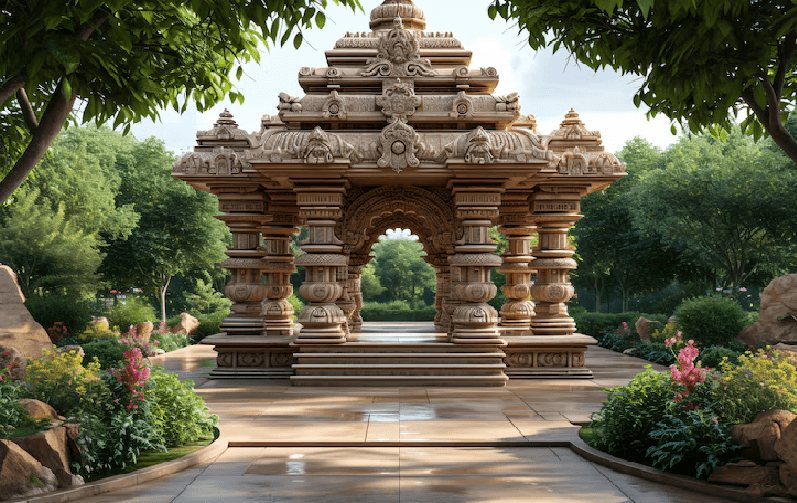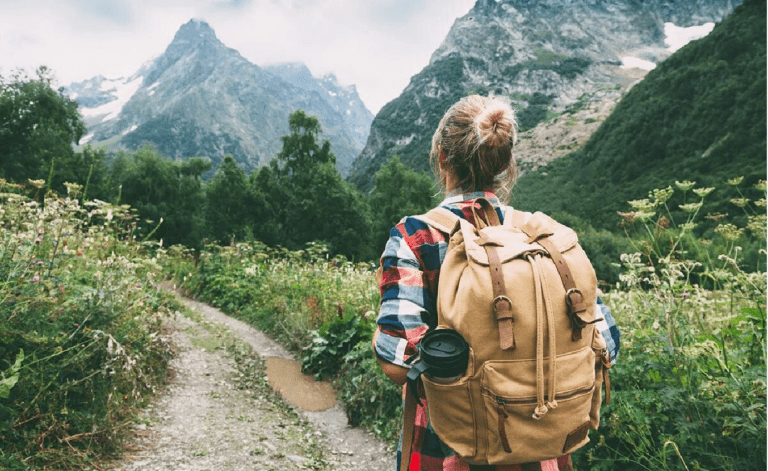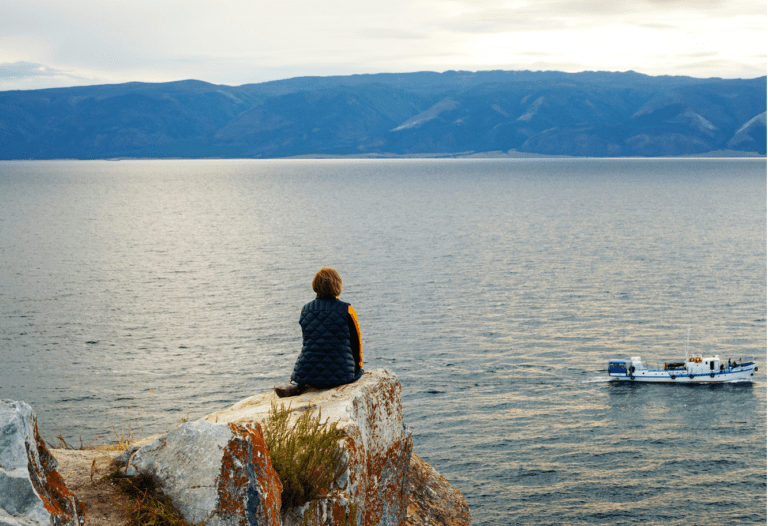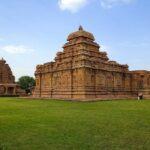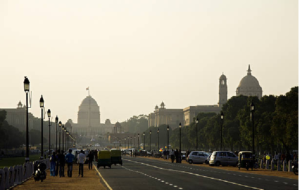
Welcome and overview:
Covering the energetic cities of Delhi, Agra, and Jaipur, India’s Golden Triangle is among the most famous and appealing travel circuits. Shaped on the map like a triangle, this area presents a rich tapestry of architectural wonders, history, and culture that has captivated visitors for millennia.
Anyone wishing to really experience the core of India should make sure they visit the Golden Triangle in 2024.
The significance of the Golden Triangle
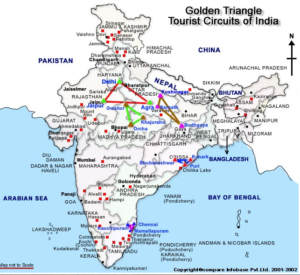
Delhi, the bustling capital of India, is a city where the past and present coexist harmoniously. Delhi provides a window into India’s varied cultural legacy, from the grandeur of its Mughal architecture to the busy markets and contemporary skyscrapers.
Home of the globally renowned Taj Mahal, Agra is a city rich with romance and history. A monument to the ageless love and architectural genius of the Mughal dynasty, the Taj Mahal is a UNESCO World Heritage site Agra also features other notable sites, including Fatehpur Sikri and the Agra Fort, each of which tells a different tale of India’s rich past.
Renowned for its grand forts, vivid bazaars, and royal palaces, Jaipur, the capital of Rajasthan, is sometimes known as the Pink City. The Golden Triangle trip finds the ideal finish amid the vibrant streets, rich customs, and kind hospitality of the city, therefore creating lifelong memories for guests.
The Value of Seeing Delhi, Agra, and Jaipur
Discovering these three cities provides a thorough awareness of the varied historical and cultural scene of India. From foodies and shopaholics to history buffs and architectural aficionados, every city has a different appeal and draws to suit different interests. Traveling the Golden Triangle is a sensory assault of sights, sounds, and tastes that captures the core of India.
What should you expect from this article?
This book guarantees a well-rounded and enriching experience by including a thorough and sequential schedule for a one-month road journey around the Golden Triangle. Recommendations for historical sites, cultural encounters, gastronomic pleasures, and hidden jewels abound.
This article provides insightful analysis and advice to help you make your trip unforgettable and hassle-free, whether it’s your first trip to India or you want to investigate these places thoroughly. Every day offers a fresh discovery, so be ready to start an amazing adventure across the heart of India.
Week 1: Discover Delhi
The energetic capital of India, Delhi, presents a varied blend of modernism, history, and culture. During the first week of your Golden Triangle trip, you will discover Delhi’s historic center and become totally engrossed in its rich legacy and famous sites. This is a comprehensive schedule for the first three days, emphasizing historical sights and monuments.
Day 1–3: Historical Sites and Monuments
Examining Delhi’s Famous Landmarks
Red Fort
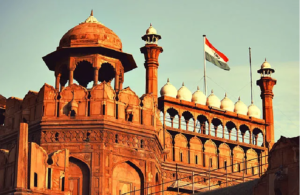
Visit the Red Fort, a UNESCO World Heritage monument honoring India’s Mughal past, to begin your trip. Emperor Shah Jahan built the fort in the mid-17th century. Its imposing red sandstone walls, stretching for two kilometers, encompass a treasure trove of Mughal architecture and a powerful legacy.
The sight of the busy Chatta Chowk marketplace, evocative of old markets, welcomes you as you go across the main entrance, Lahore Gate.
Among the important buildings in the fort complex are the Diwan-i-Aam (Hall of Public Audience), where the emperor would speak to his subjects, and the Diwan-i-Khas (Hall of Private Audience), with its breathtakingly detailed construction. Don’t miss the lovely gardens and the nightly light and sound display that chronicles the fort’s and the city’s history.
Qutub Minar
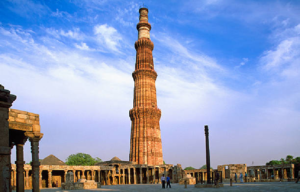
Then, at 73 meters, proceed to the tallest brick minaret in the world, the Qutub Minar. After Delhi’s last Hindu monarchy was overthrown in 1193, Qutb-ud-din Aibak ordered this remarkable structure. With its complex carvings and Quran verses, this is a wonderful example of Indo-Islamic architecture.
Surrounding the minaret lies the Qutub complex, which has other important buildings, including the Iron Pillar, which has lasted the test of time without rusting, and the first mosque constructed in India.
There are five separate levels to the minaret itself, each distinguished by a protruding balcony and tapering toward the summit. The Qutub Minar’s architectural genius and historical relevance make it a must-see.
Humayun’s Tomb
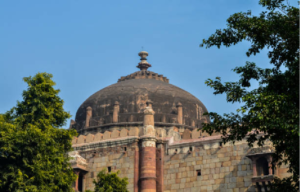
For a perfect ending to your day, explore Humayun’s Tomb, a UNESCO World Heritage Site and the architectural inspiration for the Taj Mahal. Built in the late 1560s by Empress Bega Begum, this stunning monument blends Persian influences with exquisite Indian craftsmanship. Pathways, water channels, and fountains in the four gardens that make up the tomb’s Charbagh (four garden) plan create a calm and gorgeous setting.
Surrounded by verdant gardens and several minor monuments, including the tomb of Isa Khan, the red sandstone and white marble construction holds the grave of the Mughal Emperor Humayun.
Examining the tomb and its surrounds will help you to value the exquisite workmanship and the peace of the gardens, therefore providing the ideal place for you to consider the historical path of the Mughal age.
Old Delhi
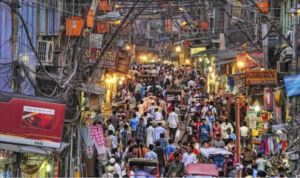
Explore Old Delhi’s busy streets to take in its energetic bazaar, ancient landmarks, and gastronomic pleasures. Immerse yourself in the vibrant chaos of Chandni Chowk, one of India’s oldest and busiest markets. Established in the 17th century by Mughal Emperor Shah Jahan, this sprawling labyrinth offers a feast for the senses.
Weave through narrow passageways overflowing with shops, where dazzling displays of spices, jewelry, and textiles compete for your attention alongside the latest gadgets and mouthwatering street food.The activity of the market offers a window into the daily life of traders and locals.
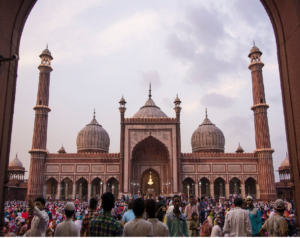
From Chandni Chowk, head for the Jama Masjid, among India’s biggest mosques. Mughal emperor Shah Jahan designed the mosque’s expansive courtyard, completed between 1644 and 1656, to accommodate over 25,000 worshippers.
An architectural wonder, the great structure boasts soaring minarets and majestic domes. Ascending one of the minarets will provide an amazing panoramic perspective of Old Delhi.
Finish your day with a classic Old Delhi experience—a rickshaw ride. See the sights, sounds, and fragrances that distinguish Old Delhi’s ancient area as you negotiate the maze-like alleyways and alleys. Apart from being a practical means of exploring the small lanes, the rickshaw ride is an adventure in itself, providing a different viewpoint on Old Delhi’s life and vitality.
By the end of these three days, you will have a greater respect of Delhi’s rich history, amazing architecture, and energetic culture, so preparing the ground for your next part of Golden Triangle travel.
Days 4–5: Modern Delhi and Cultural Interactions
It’s time to discover the current facets and cultural diversity of Delhi, following your absorption in the rich legacy of its ancient monuments and places. Over these two days, you will discover some of Delhi’s modern landmarks, museums, and energetic retail areas.
Day 4: Contemporary Museums and Landmarks
India Gate
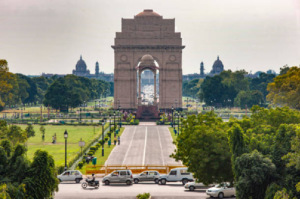
Sir Edwin Lutyens’ towering war memorial, India Gate, completed in 1931, beckons for a serene start to your day. Rising 42 meters high, this famous monument honors the 82,000 Indian troops who perished during the Third Anglo-Afghan War and World War I.
On the gate’s walls are names of these men etched there. Particularly on nights when the monument is exquisitely lit, the adjoining grounds are a common venue for picnics and leisurely strolls. Under the arch, Amar Jawan Jyoti, the everlasting flame, honors the unidentified troops.
Rashtrapati Bhavan
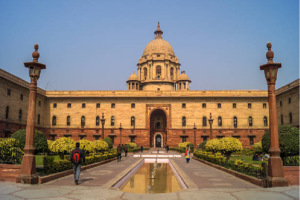
Proceed then to the Rashtrapati Bhavan, India’s official house for the President. This magnificent structure, designed by Lutyens as well, represents the height of architectural genius and splendor. Covering 320 acres, it comprises the main building with 340 rooms, the vast Mughal Gardens, and several other halls and offices.
Although Rashtrapati Bhavan’s interior is exclusively accessible by prior appointment, the public can arrange a guided tour for particular days. A must-see with a great range of flora, including roses, tulips, and bonsai plants, the Mughal Gardens are open to the public only during particular months.
Lotus Temple
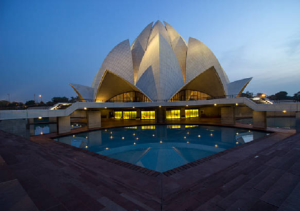
See the Lotus Temple, a Bahá’í House of Worship noted for its unique lotus-like construction, in the afternoon. Finished in 1986, this magnificent white marble construction is frequently listed as one of the most visited structures worldwide and has earned several architectural prizes.
Beyond all theological boundaries, the temple’s design reflects meditation, tranquility, and unification. Inside, the calm hall offers a quiet space for meditation and silent prayer, therefore serving as a soothing haven from the busy city.
Museums: Gandhi Smriti national museum
National Museum:
Spend the later part of the day at the National Museum, investigating Delhi’s rich cultural legacy. Housed on Janpath, this museum has a large collection of objects spanning 5,000 years of Indian history.
From the Indus Valley Civilization to the modern age, the displays comprise sculptures, paintings, fabrics, coins, manuscripts, and more. Highlights are the Buddhist Art area, the Harappan Gallery, and the Central Asian Antiquities. History buffs will find great interest in the museum’s thorough exploration of India’s varied and rich cultural legacy.
Gandhi Smriti
Visit Gandhi Smriti, the memorial to Mahatma Gandhi, to finish your day. Gandhi spent the last 144 days of his life here, on Tees January Road, before his assassination in 1948. The museum exhibits some personal relics, pictures, and records on Gandhi’s life and his support of India’s independence campaign.
The Martyr’s Column precisely identifies the location of Gandhi’s murder. Nestled on the grounds, the Eternal Gandhi Multimedia Museum presents an interactive learning tool with more thorough understanding of Gandhi’s ideas and philosophy.
Day 5: Cultural discovery and shopping
Connaught Place
Beginning your fifth day at Connaught Place, sometimes known as CP, the hub of Delhi’s retail and business activity. Robert Tor Russell’s circular design for CP distinguishes it with its Georgian-style architecture and expansive, arched halls.
With stores, restaurants, and cafes on every level, this busy neighborhood is split into inner, middle, and outside circles. From upscale labels and foreign establishments to neighborhood businesses and street vendors, CP presents a varied shopping experience. Don’t miss Janpath, a well-known market next to CP renowned for its ethnic clothes, textiles, and handcrafts.
Dilli Haat
Visit Dilli Haat, an outdoor market highlighting India’s many handicrafts, crafts, and cuisines in the afternoon Dilli Haat presents a vivid cultural experience unlike traditional marketplaces since its colorful booths reflect many states of India.
From Kashmiri shawls and Rajasthani jewelry to Madhubani paintings and South Indian pottery, this collection of handicrafts, handlooms, and artifacts reflects The food vendors offer regional cuisine, so enabling you to enjoy tastes from all throughout the nation. Dilli Haat adds to the vibrant scene by regularly featuring cultural events like folk dances and music.
On the whole, two days in modern Delhi give a full picture of the modern and cultural aspects of the city. From famous sites and historical institutions to energetic retail areas, you will encounter the lively spirit and variety of India’s capital. Delhi will always enthralls and motivate its guests with the mix of historical legacy and contemporary energy.
Days 6–7: Parks, Gardens, and Local Food
Leisure and Gastronomic Pleasures
It’s time to relax and relish Delhi’s green areas and gastronomic offerings after seeing its ancient sites and energetic markets. These two days are for leisure and indulgence in Delhi’s parks, gardens, and excellent dining scene.
Day 6: Gardens and Parks
Lodhi Gardens
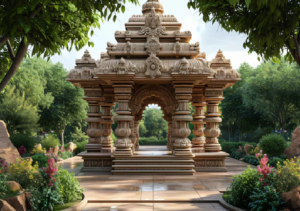
Visit Lodhi Gardens, a verdant green haven tucked away in the middle of Delhi, first thing in morning Covering more than 90 acres, this historical park is filled with relics from the Lodhi and Sayyid dynasties, including old graves. The calm surroundings and Mughal architectural grandeur make this an ideal place for an early jog or a leisurely walk.
Important sites in the park are the graves of Mohammed Shah and Sikandar Lodi, as well as the Bara Gumbad and Shisha Gumbad. With their trimmed grasses and blossoming flowers, the exquisitely designed gardens offer a peaceful haven from the busy metropolis.
Nehru Park
See Nehru Park in the afternoon, another calm green area perfect for leisurely walks and picnics. Situated in the diplomatic enclave of Chanakyapri, this approximately 80 acre park features statues, fountains, and exquisitely maintained gardens.
Families trying to unwind, yoga buffs, and morning walkers all frequent this area. To liven up its serene surroundings, the park frequently holds festivals, musical events, and cultural gatherings. Arrange a picnic blanket and relax among the verdant surroundings in a slow afternoon.
Walks at India Habitat Centre (IHC)
Walk this evening at the India Habitat Centre (IHC) as the day is ending. Known for its art galleries, theaters, and open areas, this cultural center is ideal for exploring and relaxing.
The IHC offers a rich cultural experience through cinema screenings, cultural events, and exhibits. Comprising a variety of cuisines, the complex also features various restaurants and cafes. While savoring the lively center, have a leisurely meal at one of the fine dining establishments or get a coffee from a little cafe.
Day 7: Kitchen Tour
Cooking Pleasures
Delhi’s food scene presents a gastronomic heaven with a wide range of tastes and cooking techniques. Spend today savoring the gastronomic treasures of the city, ranging from upscale dining to street food.
Street Food Tour
Starting your gastronomic adventure with a street food tour would Renowned for its vibrant street food vendors, Old Delhi offers regional specialties such kebabs, parathas, and chaat. Foodies abound in Chandni Chowk, which presents classic cuisine such jalebi, dahi benty, papri chaat, and aloo tikki.
See Paranthe Wali Gali to sample a range of packed parathas presented alongside pickles and tart chutneys. Karim’s, near Jama Masjid, is a must-visit for non-vegetarian treats because of its rich curries and tender kebabs.
Fine dining
Discover Delhi’s great dining scene in the evening, which presents a range of Indian and international cuisines. Among the famed eateries in the city are:
Indian Accent:
Renowned for its creative interpretation of classic Indian cuisine, this restaurant presents a gourmet dining experience with a contemporary edge.
Renowned for its strong North-West Frontier cuisine, Bukhara presents excellent kebabs and tandoori food.
Expert in Awadhi cuisine, Dum Pukht presents a royal dining experience with perfectly slow-cooked food.
Nestled close to Lodhi Gardens, Lodi – The Garden Restaurant offers a lovely alfresco dining environment with a menu spanning Mediterranean and world cuisines.
Exploring Food Markets
Explore some of Delhi’s well-known food marketplaces, including Khan Market and Hauz Khas Village, if you’re seeking for a more laid-back dining experience. Trendy cafés, pubs and restaurants dotted around these regions provide a blend of classic and modern cuisine. Spend a laid-back evening savoring different cuisines and taking in the energetic nightlife.
By the end of these two days, you will have experienced the ideal mix of leisure and gastronomic delight; you can rest in Delhi’s green areas and enjoy its varied dining scene.
Week 2: Agra adventures
Days 8–10: The Majestic Taj Mahal and Surroundings
Your second week in the Golden Triangle gets you to Agra, home of some of the most famous and historically important structures in India. These three days will concentrate on discovering the magnificent Taj Mahal and its environs, therefore combining architectural brilliance with cultural diversity.
Day 8: The Majestic Taj Mahal
Taj Mahal
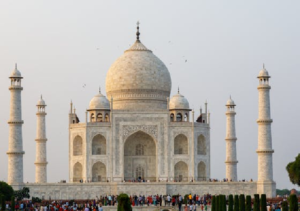
Begin your Agra journey at sunrise at the Taj Mahal Considered one of the most beautiful buildings in the world, this famous monument—a UNESCO World Heritage site—is evidence of the love Mughal Emperor Shah Jahan had for his wife, Mumtaz Mahal.
Early morning hours accentuate the ethereal splendor of the white marble mausoleum as the monument is bathed in gentle, golden light from the rising sun, producing a hypnotic effect. The Taj Mahal’s symmetrical design, calligraphy, and deft inlay work are quite remarkable.
Spend some time discovering the main mausoleum, the surrounding gardens, and the reflecting pool as well as soaking in the calm environment of this architectural wonder.
Agra Fort
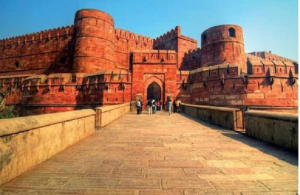
See the Agra Fort, another UNESCO World Heritage site and major historical monument in Agra, in the afternoon. Built by Emperor Akbar in the 16th century, this enormous red sandstone fort was the principal Mughal home until the capital was moved to Delhi.
The grandeur and might of the Mughal Empire are reflected in the fort’s striking architecture and deliberate construction. Among the fort’s main attractions are Jahangir’s Palace, the Khas Mahal, Diwan-i-Aam (Hall of Public Audience), and Diwan-i-Khas. From its ramparts, the fort also presents a breathtaking view of the Taj Mahal, therefore offering a different viewpoint on the two venerable sites.
Day 9: Scenic Views and Gardens
Mehtab Bag
Visit Mehtab Bagh, a lovely garden complex across the Yamuna River from the Taj Mahal, first thing in your second day in Agra Particularly in early morning or late afternoon, when the Taj Mahal is softly illuminated by diffused light, this calm garden provides an amazing perspective of the monument.
Mehtab Bagh’s precisely aligned design, with its reflecting ponds and rich vegetation, offers a great vantage point for photography and quiet introspection. Translating as “Moonlight Garden,” the name of the garden pays tribute to the breathtaking views of the Taj Mahal under starry sky.
Tomb of Itimad-ud-Daulan, Baby Taj
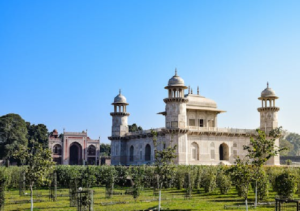
Visit the Tomb of Itimad-ud-Daulah, sometimes known as the “Baby Taj,” erected by Empress Nur Jahan for her father, Mirza Ghiyas Beg, in the afternoon. This magnificent mausoleum departs greatly from the Mughal era’s conventional red sandstone constructions.
Built totally of white marble and ornamented with delicate carvings and elaborate inlay work, the Baby Taj is regarded as a forerunner in the architectural style and design of the Taj Mahal.
History and architectural buffs should definitely visit the tomb since its graceful dimensions, verdant surroundings, and quiet atmosphere define it as a hidden treasure.
Day 10: immersion in culture
Local Markets and Handicap Crafts
Spend your third day in Agra, seeing the neighborhood marketplaces and soaking in the energetic city life. Agra is well-known for its traditional textiles, leather items, marble inlay work, and handcrafts—especially See the busy Sadar Bazaar to buy mementos, sample regional cuisine, and meet craftspeople.
Offering a large selection of traditional jewelry, clothing, and ornamental objects, the Kinari Bazaar is another excellent place to investigate.
Culinary Discovery
Savor Agra’s gastronomic treasures in the evening. Rich, aromatic cuisine like biryani, kebabs, and curries makes the city known for Mughlai. To taste these tastes, visit a nearby restaurant; alternatively, enrol in a culinary course to learn how to make classic Mughlai cuisine yourself. Try Agra’s well-known petha, a delicious treat created from ash gourd.
Thus, these three days in Agra will leave you with a rich cultural legacy, architectural marvels, and the picturesque beauty of the city. Agra unfolds a captivating tapestry of experiences on your Golden Triangle journey. Witness the awe-inspiring sunrise over the Taj Mahal, delve into the historical grandeur of Agra Fort, and find serenity at Mehtab Bagh and the Baby Taj.
Day 11–12: Investigating Agra’s Underknown Treasures
Agra’s Undiscovered Gems
Although the Taj Mahal and Agra Fort usually take center stage, Agra boasts numerous less-known but equally fascinating sites. These two days will take you to some of Agra’s hidden gems, therefore providing a closer knowledge of the rich legacy and energetic culture of the city.
Day 11: a Day Trip to Fatehpur Sikri
Fatehpur Sikri
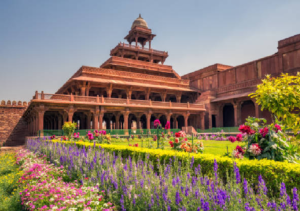
Visit Fatehpur Sikri, a UNESCO World Heritage site around forty kilometers from Agra, first thing in morning. Emperor Akbar raised this amazing deserted metropolis in the late 16th century, once the grand Mughal capital. Though fleeting in popularity, Fatehpur Sikri possesses several architectural wonders reflecting the grandeur and vision of Akbar’s rule.
Buland Darwaza
Start your investigation at the Buland Darwaza, the great entryway leading to Fatehpur Sikri. One of the highest entrances in the world, this massive construction is an arresting illustration of Mughal architecture at 54 meters high.
Jama Mosque
Adjacent to the Buland Darwaza is the magnificent mosque known as Jama Mosque, still open for worship. It is a must-see with its amazing design and delicate craftsmanship.
Tomb of Salim Chishti
Nestled inside the mosque complex, this marble mausoleum honors the Sufi saint Salim Chishti The tomb’s tranquil mood and intricate latticework are quite captivating.
Panch Mahal
The unique five-story pavilion, the Panch Mahal, was utilized for leisure and enjoyment by royal women. Thanks to the symmetrical columns and open-air design, the surrounding environment unfolds in stunning panoramic views
These halls of public and private audience highlight Akbar’s architectural creativity and administrative skills. Diwan-i-Khas and Diwan-i-Aam Especially remarkable is the finely sculpted central pillar of the Diwan-i-Khas.
Spend the day seeing these sights and appreciating Fatehpur Sikri’s historical aura. A remarkable window into the Mughal era is provided by the well-preserved buildings and the distinctive mix of Persian, Indian, and Islamic architectural forms used in the city.
Day 12: Agra shopping and Akbar’s tomb
The tomb of Akbar in Sikandra
Visit Akbar’s Tomb in Sikandra in Agra’s outskirts first thing in morning. Emperor Akbar’s last resting place is this magnificent tomb, which sits within lovely, expansive gardens. Reflecting Akbar’s goal of religious tolerance and cultural synthesis, the tomb’s construction is a singular mix of Hindu, Islamic, and Persian forms.
Entrance Gateway:
Each of the four red sandstone gates, which face a cardinal direction, is exquisitely carved and ornamented with inlay work.
Main Mausoleum:
Built mostly of red sandstone and white marble, the major construction, the Main Mausoleum, features calligraphy and geometric designs. The basic, unadorned tomb room itself contrasts with the ornate outside.
Gardens:
The tomb finds a calm and beautiful backdrop from the surrounding Charbagh (four gardens) arrangement with its paths, water channels, and fountains.
Spend some time strolling over the gardens, seeing the resident deer and peacocks, and absorbing the architectural beauty and historical relevance of Akbar’s Tomb.
Shopping in Agra
Spend the afternoon shopping and touring Agra’s energetic markets, which are known for their leather goods, textiles, marble inlay work, and handcrafts.
Sardar Bazar: From clothes and accessories to spices and souvenirs, Sadar Bazar is a hive of activity where you may find anything. Additionally, well-known in the market are street food vendors providing regional specialties.
Kinari Bazar: Near the Jama Mosque, Kinari Bazaar is well-known for its traditional jewelry, bridal apparel, and décor pieces. Wander the little roads and explore the colorful stores for a vibrant shopping adventure.
Marble Handicraft Shops: Agra is well-known for its Mughal era marble inlay art, a craft. See finely crafted marble goods, including tabletops, coasters, and ornamental accents, by visiting neighborhood craft stores. These objects are really beautiful presents and keepsakes.
These two days in Agra will reveal some of the city’s hidden treasures, therefore enhancing respect of its historical legacy and cultural variety. From the architectural beauty of Fatehpur Sikri and Akbar’s Tomb to the energetic markets bursting with local goods, you will discover the less-known features of Agra that add to its particular appeal.
Days 13–14: Relaxation and Cultural Immersion
Relax and Enjoy Local Culture
Spend these two days unwinding, rejuvenating, and really immersing yourself in the rich cultural offerings of Agra as your stay there comes to an end. From opulent spa treatments to energetic cultural events and fine Mughlai food, these encounters will leave you with lifetime memories of your trip over India’s Golden Triangle.
Day 13: Spa Day and Cultural Show
Spa in the Heritage Hotel
Start your day in Agra in a classic hotel with a leisurely spa treatment. Many of these hotels provide massages, wellness therapies meant to revitalize the body and soul, as well as Ayurvedic treatments.
To reduce tension and advance general well-being, indulge in treatments including Pizhichil (oil bath), Shirodhara (oil pouring on the forehead), and Abhyanga (oil massage). The calm atmosphere of the historical hotel and the therapists’ expert hands will guarantee a revitalizing encounter.
Cultural Exhibition housed in Kalakriti Cultural & Convention Center
Visit the Kalakriti Cultural & Convention Center for an evening cultural performance. Regular events at this location highlight theater, dance, and traditional Indian music.
Along with beautiful music performed on traditional instruments including the tabla, sitar, and flute, experience the energetic rhythms of classical dance genres including Kathak and Bharatanatyam.
Often featuring traditional dances highlighting India’s vast artistic legacy and thereby honoring its varied cultural legacy, the performances offer a greater respect for Indian culture, the vibrant clothes, elegant motions, and expressive gestures of performers will fascinate and enthrall you.
Day 14: Foodies
Mughlai Culinary Arts
Savour Mughlai cuisine at famous eateries all around Agra on your last day here. Inspired by the Mughal rulers’ cooking, Agra’s gastronomic scene is known for its rich and aromatic meals. Sample foods, including:
Biryani: Fragrant rice cooked with tender meat (pork, mutton, or beef), aromatic spices, and saffron creates a rich and filling dish.
Kababs: Grilled to perfection over charcoal, succulent bits of marinated meat—such as chicken or lamb—infused with smokey flavors—served with mint chutney.
Rich Cuirries: Indulge in sumptuous and decadent creamy curries created with soft chunks of meat or vegetables cooked in a mix of spices, yogurt, and occasionally nuts or cream.
Suggested Restaurants:
Pinch of Spice: Renowned for its real Mughlai and North Indian food, this restaurant has a warm atmosphere and a large range of delectable cuisine.
Jahanpanah: Near the Taj Mahal, Jahanpanah specializes in authentic Mughlai cuisine, with meals highlighting the rich gastronomic legacy of the area.
Peshwari (ITC Mughal): Experience the rustic tastes of the North-West Frontier in Peshawri, noted for its strong kebabs and tandoori specialties made in traditional clay ovens.
Thus, these two days in Agra combine culinary pleasures, cultural immersion, and leisure time perfectly. Whether your trip through Agra ends with Ayurvedic treatments at a heritage hotel spa, the vibrant performances at Kalakriti Cultural & Convention Center, or the rich flavors of Mughlai cuisine, you will leave with a great respect for Agra’s cultural legacy and friendly hospitality.
Week 3: Road to Jaipur.
Day 15–17: Arrival and Initial Discovery
About aipur
After discovering Agra’s historical and cultural treasures, set off on your trip to Jaipur, the energetic capital of Rajasthan. These three days will show you the architectural wonders, royal legacy of Jaipur, and vibrant markets that define the Pink City and help create a unique trip here.
Day 15: Head from Agra to Jaipur.
Choices for Travel
Start your morning by traveling roughly 240 kilometers from Agra to Jaipur. From your many travel choices, you:
Train: From Agra to Jaipur, use the Indian railway system. Trains let you enjoy the countryside scenery all along their comfortable and picturesque path.
Bus: Choose a handy and reasonably priced bus ride. From Agra, buses leave regularly and travel about 4–5 hours to get Jaipur.
Road Trip: Set off a picturesque road trip from Agra to Jaipur to have a more individualised experience. The road offers chances to stop and investigate nearby sites as it winds through charming rural settings and small villages.
City Palace
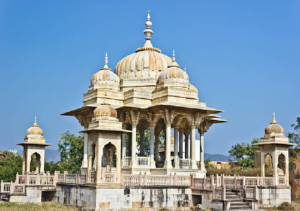
Once in Jaipur, begin your research at the architectural wonder known as City Palace, which combines European, Mughal, and Rajput styles. Among various palaces, courtyards, museums, and gardens, this expansive complex houses City Palace’s highlights consist in:
Chandra Mahal: The royal family’s house and evidence of Jaipur’s regal legacy, Chandra Mahal admires the palace interiors’ elaborate décor, vivid frescoes, and deft craftsmanship.
Mubarak Mahal: Showing an amazing array of royal clothes, fabrics, weapons, and armor, Mubarak Mahal is a museum. Discover the rich legacy of culture kept just within its boundaries.
Pitam Niwas Chowk: Four elegantly designed gates representing the four seasons and Hindu gods beautify a courtyard known as Pitam Niwas Chowk.
Jantar Mantar
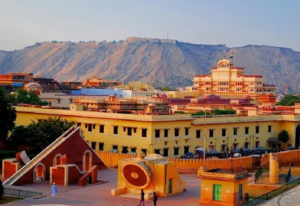
In the afternoon, head to Jantar Mantar, an astronomical observatory Maharaja Sawai Jai Singh II built in the 18th century. Among architectural and astronomical instruments included at this UNESCO World Heritage site are the biggest stone sundial in the world.
Discover historical astronomy methods and marvel at the accuracy with which these tools track celestial bodies, forecast eclipses, and measure time.
Day 16: Markets and Local Culture
Marketplaces of Jaipur
Spend the evening perusing Jaipur’s energetic markets, which are well-known for their vivid collection of textiles, handicrafts, jewelry, and traditional Rajasthani clothing. Two of the most traveled to markets are:
Johari Bazaar is renowned for its magnificent jewelry—including traditional Kundan and Meenakari pieces as well as jewels, silver accents. Look along the little roads dotted with stores offering necklaces, earrings, and glittering bangles, renowned for its textiles, vivid materials, and striking Rajasthani clothing,
Bapu Bazaar looks among booths presenting hand-block printed textiles, embroidered clothing, and traditional shoes like mojaris. Don’t miss the chance to bargain and hunt for mementos to bring back home.
Local Foods
Sample authentic Rajasthani food to savor the gastronomic pleasures of Jaipur. Try favorites such Laal Maas (hot mutton curry), Gatte ki Sabzi (gram flour dumplings in spicy yogurt gravy), and dal baati churma, a savory meal of lentils, wheat rolls, and sweetened crumbs). Savor Ghevar, a classic Rajasthani sweet made from wheat and steeped in sugar syrup, for dessert.
Day 17: Craftsman Studios
Artisan Studios
Visit workshops and businesses where traditional crafts are carried on to fully appreciate Jaipur’s rich artistic legacy in the afternoon. See expert craftspeople producing block-printed fabrics, handcrafted pottery, marble sculptures, and complex lac jewelry. Participate in interactive seminars to pick up the artistic traditions and methods handed down over the years.
Thus, these three days in Jaipur present a fascinating introduction to the royal legacy of the city, architectural wonders, energetic markets, and rich cultural traditions.
Discover why Jaipur is regarded as the Pink City and a gem in India’s cultural crown, from touring the lavish City Palace and antique astronomical instruments at Jantar Mantar to shopping for wonderful handcrafts and enjoying traditional Rajasthani cuisine.
Days 18–20: Royal Forts and Palaces
Exploring Jaipur’s Past
Visit its beautiful forts, each providing distinct insights on the architectural grandeur, strategic relevance, and cultural legacy of Jaipur, while continuing your trip through its regal history.
Day 18: Amer Fort and Show on Light & Sound
Amer Fort
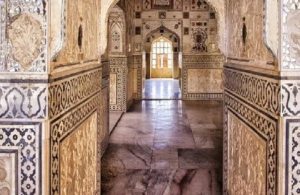
Visit Amer Fort, a magnificent fortification perched on a hilltop around 11 kilometers from Jaipur, first thing in morning. Built of red sandstone and marble, Amer Fort is a UNESCO World Heritage site known for its mix of Mughal and Rajput architectural styles. Highlights of Amer Fort consist:
Sheesh Mahal:
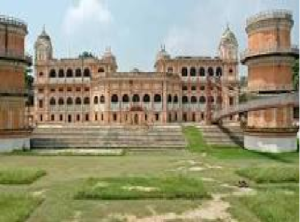
Admire the complex mirror work and vibrant glass mosaics covering the walls and ceilings of this magnificent palace chamber in Sheesh Mahal, Hall of Mirrors.
Diwan-i-Aam and Diwan-i-Khas: Explore the public and private audience halls where the king handled administrative tasks and court.
Ganesh Pol and Suraj Pol: Marvel at the elaborate gateways leading into several parts of the fort, each exhibiting complex carvings and architectural grace.
Elephant Ride: Experience the splendor of Amer Fort with an optional elephant ride up the hill, evoking a former royal procession.
Attending the Light and Sound Show at Amer Fort in the evening will help you experience the history and stories of the fort with vibrant lights, music, and narration. The performance offers a fascinating window into the life of Jaipur’s leaders as well as the importance of the fort in Rajasitan history.
Day 19: Jaigarh Fort and Nahargarh Fort
Jaigarh Fort
See the Amber Fort and Maota Lake from Jaigarh Fort, perched on Cheel ka Teela (the Hill of Eagles), on top of which, constructed in the 18th century, Jaigarh Fort is renowned for: military might and is used as such.
Jaivana Cannon:
Discover the biggest cannon on wheels in the world right here in the fort, the Jaivana Cannon. Cast in the foundry of the fort, this enormous cannon is evidence of Jaipur’s military might.
Palace complex:
Discover the several palaces and buildings housed within Jaigarh Fort, including the stunning walls, gateways, and watchtowers providing panoramic views of the surroundings.
Fort Nahargarh
Visit Nahargarh Fort, another hilltop fort included into Jaipur’s defense ring, along with Jaigarh Fort and Amer Fort, to keep exploring. The Fort of Nahargarh provides:
Scenic vistas:
Particularly at sunset, when the sky is painted orange and pink, savor the amazing vistas of Jaipur metropolis. Unwind at Madhavendra Bhawan, a serene palace complex featuring interconnected rooms for the royal family, adorned with finely crafted halls and chambers.
Day 20: Albert Hall Museum
Albert Hall’s Museum
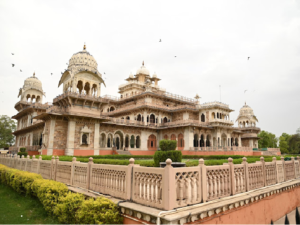
Visit the Albert Hall Museum, housed in Ram Niwas Garden, to round up your study of Jaipur. Designed in Indo-Saracenic architecture, this museum features a vast collection of relics, artwork, and displays honoring Jaipur’s cultural legacy. Highlights of the museum consist:
See a rare Egyptian mummy that offers a window into ancient civilizations and worldwide cultural links thousands of years ago.
Rajasthani arts and textiles: Admire the wonderful Rajasthani miniature paintings, traditional attire, fabrics, and jewelry on show in the museum’s galleries.
Center courtyard: Find a spot in the central courtyard, amidst marble pillars and arches, to soak in the museum’s architectural grandeur.
Thus, these three days in Jaipur will fully expose you to the architectural wonders, cultural riches, and royal legacy of the city. From the splendor of Amer Fort and the military prowess of Jaigarh Fort to the sweeping vistas from Nahargarh Fort and the cultural insights at Albert Hall Museum, Jaipur presents a fascinating trip through Rajasthan’s royal history and vivid present.
Day 21: Regional Crafts and Arts
Get Lost in Traditional Arts
Spend your last day in Jaipur experiencing local handicap skills passed down through generations by means of hands-on activities and visiting its rich history of arts and crafts.
Workshop on block printing
Visit a block printing factory first thing in the morning to learn about this ancient art form linked with Jaipur’s cultural character. Using finely carved wooden blocks to stamp patterns onto cloth, block printing creates vivid and complex designs.
Take part in a session run by talented artists who will walk you through the process—from selecting colors and designs to honing block printing technique. As a special memento of your trip to Jaipur, design your own bespoke block-printed cloth.
Potter Village
Go to a Pottery Village.
Then, travel to a nearby pottery hamlet on the outskirts of Jaipur to see craftspeople employing age-old methods to shape clay into exquisite ceramics. Renowned for its unique blue glaze, a Persian technique taken up and refined in Rajasistan, Jaipur’s ceramics See expert potters shape clay on the potter’s wheel and embellish completed pieces with detailed designs.
Under the direction of local artists, try your hand at pottery making to have practical experience and develop a greater respect for this age-old craft reflecting Jaipur’s creative legacy.
Shopping in Jaipur
Look for handcrafted treasures in shops.
Discover Jaipur’s energetic markets and boutiques in the afternoon, known for their magnificent handcrafted gifts. Some must-see places include:
Blue pottery:
Purchase utilitarian and beautiful objects created from Jaipur’s well-known blue pottery, distinguished for its vivid blue tones and floral patterns. Search for bowls, plates, vases, and tiles highlighting the skill of nearby craftspeople.
Textiles:
Look among hand-block printed fabrics, embroidered clothing, and Rajasthani bandhani (tie-dye) textiles. Every piece captures the complex workmanship and vivid colors characteristic of Rajasitan textile customs.
Jewelry:
Search the jewelry marketplaces of Jaipur, renowned for their complex patterns and expert workmanship. Shop for semi-precious gemstone-adorned Kundan, Meenakari, and silver jewelry ideal for accentuating Rajasthani elegance in your line-up.
Day 21’s end
Spend your last day in Jaipur fully immersed in the thriving arts and crafts sector to learn directly about block printing and pottery manufacturing. From the painstaking workmanship of block printers and potters to the complex designs of blue pottery and textiles, find the beauty in Jaipur’s ancient arts.
Discover the markets of Jaipur and search for distinctive handcrafted items that perfectly reflect the spirit of Rajasistan’s cultural legacy to guarantee lifetime memories of your transforming trip around the Pink City.
Week 4: Natural and cultural beauties of Jaipur
Days 22–24: Nature and Wildlife Excursions
Day 22: Day Trip to National Park of Ranthambo.
National Park Ranthambore
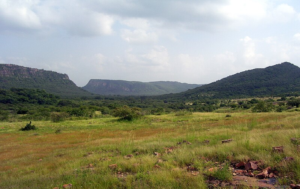
Starting an early morning excursion, spend a day at Ranthambore National Park, one of the biggest national parks in India and a well-known wildlife refuge.
Safari Tour:
Ranthambore, which is around 160 kilometers southeast of Jaipur, is well-known for its Bengal tiger population and varied array of other animals.
Your trip could feature sightings of tigers, leopards, sloth bears, sambar deer, and many bird species. On an open jeep or canter, savor an exciting safari ride around the park’s deep forests, meadows, and lakeside.
The seasoned naturalist guide will assist in spotting animals and provide knowledge on the ecosystem of the park and conservation initiatives.
Historical attractions:
See the ancient Ranthambore Fort inside the park. This UNESCO World Heritage site provides sweeping perspectives of the nearby ecosystems and scenery.
Day 23: Ram Niwas Garden and Jaipur Zoo
Rajniwas Garden and Jaipur Zoo
Spend a relaxing day touring the Ram Niwas Garden and Jaipur Zoo, which are in the middle of Jaipur city. The expansive public park known as Ram Niwas Garden features a number of attractions including:
Jaipur Zoo:
Discover at Jaipur Zoo a range of global animal species including tigers, leopards, elephants, and rare birds. Naturalistic cages at the zoo offer a window into the habitats and actions of these species.
Central Museum:
Explore the history and culture of Jaipur at the Central Museum, which exhibits relics, manuscripts, and archeological discoveries connected to Rajasthan.
Day 24: Man Sagar Lake and Jal Mahal
Jal Mahal and Surrounded Lake
Visit Jal Mahal, a charming palace tucked away among Man Sagar Lake, to wrap up your tour of the natural beauties of Jaipur. Renowned for their location—half immersed in the lake’s waters—this amazing architectural wonder is breathtaking. Highlights of Jal Mahal and Man Sagar Lake consist in:
Scenic views : Especially around sunrise or sunset, savor magnificent vistas of Jal Mahal against the Aravalli Hills.
Boat ride: Take a calm boat trip on Man Sagar Lake to have close-up views of Jal Mahal and the surroundings.
Photography: A preferred location for photographers and nature lovers, Jal Mahal’s reflection in the calm lake waters is breathtaking.
From the thrilling safari experience at Ranthambore National Park to the peaceful settings of Jaipur Zoo, Ram Niwas Garden, and Jal Mahal, these three days in Jaipur will envelop you in the natural beauty and wildlife wonders of Rajasistan.
Discover many habitats, see amazing animals, and marvel at architectural masterpieces among calm natural surroundings to guarantee a unique ending to your trip to India’s Golden Triangle.
Days 25–26: celebrations and fairs.
Day 25: Attending Local Festivities
Regional Festivities
Participating in local celebrations, if any are planned for your trip, can help you really appreciate the vivid cultural tapestry of Jaipur. Colorful celebrations of customs, music, dance, and religious events abound throughout Rajasthan. The timing of your visit will determine if you have the chance to see:
Teej Festival: Celebrated during the monsoon, Teej is a women-centric event with processions, folk music, traditional dances, including the Ghoomar, and colourful clothing.
Elephant Festival: Celebrated during Holi, the Elephant Festival offers cultural events, adorned elephants, and elephant polo contests.
Jaipur Literature Festival: Should your trip fall in January, make sure to visit the Jaipur Literature Festival, one of the biggest literary events worldwide with esteemed writers, intellectuals, and cultural events.
Village Chokhi Dhani
Emphasizing the rich cultural legacy of the state, Chokhi Dhani presents a classic Rajasthani experience. Comprising mud huts, folk performances, traditional cuisine, and activities including camel rides, puppet shows, and mehendi (henna) art, this village resort on the outskirts of Jaipur replicates a rustic Rajasthani village scene.
Spend an evening savoring real local cuisine such dal baati churma, ker sangri, and gatteki sabzi presented in traditional thalis, immersed in Rajasthani hospitality.
Day 26: Visit a Local Market or Fair
Local Market Fair
Finish your trip through Jaipur by visiting a nearby fair or market, where you may relax in the vibrant environment and browse for mementos and handicrafts. The markets in Jaipur are well-known for their vivid hues, deft workmanship, and unusual goods. visit:
Bazaars:
Discover vibrant bazaars with textiles, jewelry, handcrafts, and traditional Rajasthani clothing like Johari Bazaar, Bapu Bazaar, and Tripolia Bazaar. Bargain for block-printed fabrics, embroidered linens, silver jewelry, and vibrantly colored crockery.
Local Fairs:
Depending on the season, visit local fairs (melas) highlighting rural Rajasitan customs, handcrafted goods, and cultural events. Traditionally, Rajasthani cuisine, folk music, dance performances, and camel and cow displays abound in fairs.
Enjoy live presentations of folk music and dance, including the dynamic Kalbelia dance, Ghoomar, and Bhawai, presented by talented artists clothed in vivid colors.
From taking in Rajasthani customs at Chokhi Dhani to visiting energetic markets and going to local fairs, these two days in Jaipur will present a rich tapestry of cultural events. Accept the hues, tastes, and rhythms of Rajasistan’s cultural legacy to guarantee a remarkable end to your epic trip over India’s Golden Triangle.
Day 27–28: Farewell and Relaxation
Day 27: Day of relaxation in a luxury resort or spa
opulent hotel or spa
Spend your penultimate day in Jaipur relaxing and recuperating at a luxury hotel or spa where you may enjoy peaceful surroundings and luxurious treatments. Several famous resorts and spas in Jaipur give world-class hospitality and wellness experiences:
Spa: Ayurvedic therapies inspired by ancient Indian therapeutic practices, aromatherapy sessions, and rejuvenating massages are treats for you.
Facilities: Take advantage of swimming pools, yoga and meditation centers, and verdant gardens perfect for rest and release.
Food: Savor gourmet cuisine with local and foreign tastes presented in sophisticated dining environments or outdoors among calm surroundings.
Day 28: Last-minute shopping and farewell thoughts
Final Shopping and Souvenir Hunting
Spend your last morning in Jaipur browsing its energetic markets and bout-let stores, gathering souvenirs to mark your trip. Visite:
Marketplaces:
Go back to Johari Bazaar, Bapu Bazaar, or other preferred marketplaces to search for last-minute items like textiles, jewelry, handicrafts, and ancient Rajasthani relics.
Speciality Stores:
Ideal for gifts and souvenirs, investigate specialist businesses providing distinctive products including blue pottery, block-printed fabrics, miniature paintings, and gemstone jewelry.
farewell meal
Finish your amazing trip around Jaipur with a farewell meal at a well-known restaurant where you may enjoy worldwide cuisines and delicious Rajasthani in unique surroundings. From:
Fine Dining: Choose a restaurant well-known for its atmosphere and cuisine that presents food highlighting global influences and Rajasitan tastes.
Cultural Performances: Reflecting Jaipur’s artistic legacy, enjoy live music or dance shows to enhance your dining experience.
Contemplation and thanksfulness
As you savor your last hours in Jaipur, consider your experiences in India’s Golden Triangle. Share thanks for the unique cultural interactions, historical wonders, and kind hospitality that have enhanced your trip. Photographs of the famous sites and scenery of Jaipur can help you to capture memories of this magical city that will last.
These last two days in Jaipur present opportunities for celebration, rest, and introspection, so complete your epic journey in the Golden Triangle of India. From calm spa treatments and souvenir shopping to a special farewell dinner, treasure the memories and relationships created on your trip through the energetic capital of Rajasthan.
Conclusion
Considering the Road
Consider the complex tapestry of events, cultural interactions, and historical wonders that have shaped your trip to Delhi, Agra, and Jaipur as your path through India’s Golden Triangle draws to an end.
From busy cityscapes to peaceful settings, every location has given a different window into India’s varied legacy and energetic customs in 2024.
Highlights and Synopsis of the Events
As you travel:
Delhi: Explore the busy streets of Old Delhi, discover the ancient sites of the capital, including the Red Fort and Qutub Minar, and savor gastronomic pleasures.
Agra: Take in Mughal art and architecture, marvel at the Taj Mahal at sunrise, tour the grand Agra Fort and discover lesser-known treasures like Fatehpur Sikri.
Jaipur: Discover Jaipur’s cultural legacy via local arts and crafts, see royal forts and palaces, including Amer Fort and City Palace, and savor wildlife trips and calm natural settings.
Advice for Travelers of Tomorrow
For visitors organizing their own trip:
Timing: See during October to March, when cooler months are perfect for sightseeing.
Local culture: Respect regional customs and traditions, especially when visiting holy sites and taking part in celebrations.
Transportation: Travel between locations is flexible and quickly using a combination of railroads, buses, and private drivers.
Invitation to Readers to Comment and Share Their Experiences
We cordially encourage you to provide comments and personal experiences from your trip across the Golden Triangle of India. Whether you came across hidden treasures, sampled regional cuisine, or came upon unanticipated moments of wonder, your stories add to the fabric of travel memories.
We appreciate you setting off this remarkable trip using this article. Delhi, Agra, and Jaipur will ignite your wanderlust and enrich your future travels around the globe.
Till we cross paths once more on yet another voyage, safe travels!
Extra Resources
Travel Guide & Essentials
Packing Advice for a Month-Long Vacuum
Choose light, airy clothes fit for India’s several climates.
Add suitable walking shoes, sunscreen, a cap, and bug spray.
Pack a little medical kit, including antiseptics, bandages, and medications.
Stow a portable power bank and a universal adapter for charging gadgets.
Advice on Safety and Health
Keep hydrated and sip either bottled or filtered water.
Use hand sanitizer and follow good hygienic standards, including regular hand washing.
With street food, be careful and make sure it’s freshly made.
As you explore, keep updated on local customs and safety advice.
Travel Services and Local Guides
Local Guides:
Through respectable travel companies or hotel concierges, get in touch with accredited guides.
Know the local emergency numbers and save contacts for your consulate or embassy.
Suggestions for Reading and Watching
Books, films, and documentaries concerning the Golden Triangle
Books:
William Dalrymple’s ” City of Djinns: A Year in Delhi”
Ebba Koch, “The Taj Mahal: Architecture, Symbolism, and Urban Significance.”
“Jaipur Names: Tales from the Pink City” by Giles Tillotson
Movies:
Filmed largely in Rajasthan, “Lagaan” (2001) is a Bollywood epic set during British colonial control.
“Jodhaa Akbar” (2008) is a historical romantic movie with cultural background of Agra and Jaipur.
Documentaries:
“The Story of India” (2007) is a PBS documentary series delving on India’s past and cultural variety.
“Secrets of the Taj Mahal” (2017) is a National Geographic documentary revealing the secrets of the Taj Mahal building technique.
Links to Travel blogs and Related Articles
Invest additional research on the Golden Triangle and use reliable travel advice on respectable blogs and websites.
Consult travel forums for personal knowledge and suggestions from other visitors.
For current information on destinations, events, and local perspectives, visit official tourism websites.

